Introduction
Theraphosidae is the most diverse family of mygalomorph spiders, with 984 described species known to date (World Spider Catalog 2020), however, theraphosids are also known for their great morphological homogeneity which makes difficult the diagnosis and identification of species (Raven 1985; Pérez-Miles et al. 1996; Bertani 2000; Perafán & Pérez-Miles 2014; Ferretti 2015; Lapinski et al. 2018).
The new genus BistriopelmaKaderka 2015 was created to accommodate Peruvian tarantulas having two abdominal dorsolateral patches of the type III urticating setae, two subparallel seminal receptacles that ended with transverse oval lobes in females and male palpal bulb with long, sigmoidal curved embolus carrying two prolateral keels, superior and inferior prolateral keel. In 2017, after a field work carried out in Peru, the same author collected and described the male of B. matuskai Kaderka 2015 and described a new species from Puno, B. titicaca Kaderka 2017. Recently, two new species have been described from Apurimac and Cusco (Nicoletta et al. 2020) and to date, this genus is represented by five species that inhabit the Andean region in Peru: B. lamasi Kaderka 2015, B. matuskai Kaderka 2015, B. titicaca Kaderka 2017, B. peyoi Nicoletta, Chaparro, Mamani, Ochoa, West & Ferretti, 2020 and B. kiwicha Nicoletta, Chaparro, Mamani, Ochoa, West & Ferretti, 2020 (World Spider Catalog 2020).
The female paratype of B. kiwicha appears to be an immature specimen in comparison with the carapace length of the male holotype, or may belong to a different species inhabiting geographically similar area above Urcos (pers. obs., in prep.), approximately 20 km far from B. kiwicha paratype. The carapace length of the female paratype reaches only 60 per cent of male carapace length. This female paratype was found approximately 12 km far from the male holotype locality at the other bank of the Urubamba River. For those reasons, we suggest a comparative analysis for males and females from both populations of B. kiwicha to accurately assess the taxonomic status of B. kiwicha paratype. In regards to B. peyoi, the original description of the male holotype (Nicoletta et al. 2020) shows instead the palp of B. kiwicha and after communicating it to the authors they sent us the right illustration, which is presented here with their consent (Nicoletta & Ferretti, pers. comm.).
In June 2017, a single male of the genus Bistriopelma was deposited in the arachnid collection of the Museo de Historia Natural de la Universidad Nacional de San Agustín de Arequipa (MUSA). The spider was found in a Polylepis rugulosa forest located on the slopes of Pichu Pichu volcano, Buffer Zone of Salinas and Aguada Blanca National Reserve, Arequipa. Later, in January 2018, a single male and two females were collected during fieldwork in a nearby area of the same forest. In the present work, a new species of Bistriopelma is described, diagnosed, and illustrated. The occurrence of Bistriopelma in this forest highlights the importance of conserving the Polylepis forests in the Arequipa region.
Material and methods
Abbreviations: Eye sizes and interdistances: AME = anterior median eyes, ALE = anterior lateral eyes, OQ = ocular quadrangle (including lateral eyes), PME = posterior median eyes, PLE = posterior lateral eyes. Spination: d = dorsal, p = prolateral, r = retrolateral, v = ventral. Cymbium: RL = retrolateral. Male palpal bulb: E = embolus, PI = prolateral inferior keel, PS = prolateral superior keel, T = tegulum. Cheliceral teeth pattern: v = small teeth, V = big teeth, - = space. PLS = posterior lateral spinnerets, PMS = posterior median spinnerets. Collections: MUSA = Museo de Historia Natural de la Universidad Nacional de San Agustín de Arequipa, Arequipa, Peru. MUSM = Museo de Historia Natural de la Universidad Nacional Mayor de San Marcos, Lima, Peru. MUBI = Museo de Biodiversidad del Perú, Cusco, Peru. MCZ = Museum of Comparative Zoology, Cambridge, U.S.A. m a.s.l. = meters above sea level.
Specimens were examined using a ZEISS Stemi 305 stereomicroscope and digital images were taken with a Canon PowerShot SX530 HS digital camera directly or via eyepiece of the stereomicroscope according to the central axis of structures. Line drawings were traced by hand according to the photos, using a transparent foil. All measurements are given in millimeters using a digital dial caliper with an error of 0.01 mm. The measurement of the total body length includes cephalothorax and abdomen, excluding chelicerae and spinnerets. The measurements of the leg and palpal segments were taken dorsally. The eye measurements were taken from the widest spans of the lens, AME in dorsal view, ALE, PLE and PME in dorsolateral view.
The extent of tarsal and metatarsal scopulae on ventral side of both leg segments was expressed as a percentage of the total length of segment, from the apical end.
The leg spination was described using the following method: each leg segment was divided into four quadrants (ventral, prolateral, retrolateral and dorsal) and each quadrant described separately in basal, central and apical section, e.g. metatarsus I v 1-0-3 means that in the ventral plane (quadrant) there is one spine in basal section and three spines in apical section. If the bases of all three spine in apical section are located apically, then their position would be described by the term "apical" in brackets as in Bertani (2001). Unequal numbers of spines on the right and left side of the same leg segment were expressed by parentheses.
The denticulation of paired tarsal claws is described separately for prolateral and retrolateral claw (prolateral/ retrolateral).
To make a proper examination, the female genitalia was detached from abdomen. The terminology of male palpal bulb structures follows Bertani (2000). The terminology of subapical apophyses on tibia I follows Vol (2000) and Kaderka (2015).
The abdominal urticating setae were removed by forceps, placed in alcohol, and examined by a stereomicroscope. The terminology of urticating setae follows Cooke et al. (1972).
GPS coordinates were obtained using a Garmin MAP62s. The distribution map of the genus Bistriopelma was prepared using Arc-GIS (version 10.1).
Other material examined: Bistriopelma sp., male and female (MUSM-ENT 0511177) from PERU, Puno, Titicaca Lake, Isla Amantani, 3900 m a.s.l., March 1948, Fortunato Blancas col.
Taxonomy
Order: Araneae Clerck 1757
Family: Theraphosidae Thorell 1869
Subfamily: Theraphosinae Thorell 1869
Genus: Bistriopelma Kaderka 2015
Bistriopelma fabianae Quispe-Colca and Kaderka sp. nov.
Figures 1 - 5, 6A, 6B, 8, Tables 1 - 2
Type material: Male holotype (MUSA-AR 001) fromPERU, Arequipa, buffer zone of Salinas and Aguada BlancaNational Reserve, Chiguata, El Simbral, Queñua forest (Polylepis rugulosa Bitter), 16°23’27.14"S 71°19’5.47"W, 4060m a.s.l., 21 May 2015, O. M. Quispe-Colca col.; male paratype(MUSA-AR 103) ibid., Caccayaco, Queñua forest (Polylepis rugulosa Bitter), 16°25’41.90"S 71°20’4.46"W, 3547 m a.s.l.,13 January 2018, O. M. Quispe-Colca col.; female paratype(MUSA-AR 104) ibid., Caccayaco, Queñua forest (Polylepis rugulosa Bitter), 16°25’37.40"S 71°19’59.09"W, 3575 ma.s.l., 13 January 2018, O. M. Quispe-Colca col.; female paratype (MUSA-AR 105) ibid., Caccayaco, Queñua forest (Polylepis rugulosa Bitter), 16°25’44.01"S 71°20’7.89"W, 3535m a.s.l., 13 January 2018, O. M. Quispe-Colca col.
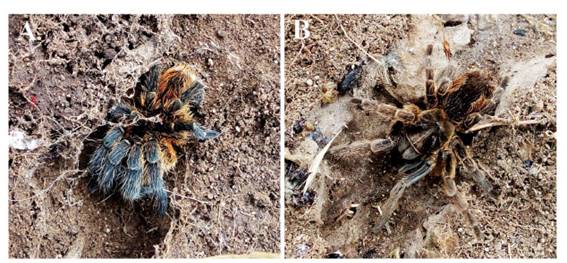
Figure 1 Bistriopelma fabianae sp. nov., habitus, dorsal view. A. Male paratype (MUSA-AR 103). B. Female paratype (MUSA-AR 104). Both from Chiguata, Caccayaco, Queñua forest, buffer zone of Salinas and Aguada Blanca National Reserve, Arequipa. Photos by O. M. Quispe-Colca.
Diagnosis: Specimens of Bistriopelma fabianae sp.nov. differ from B. matuskai and B. peyoi in the presence of fovea (absent in B. matuskai and B. peyoi). Males of B. fabianae sp. nov. differ from the rest of congeners in the presence of a short apophysis between cymbial lobes, whichis densely covered with short spiniform setae. Males alsodiffer in the different leg pattern (I>II>IV>III in B. fabianae sp. nov. and B. kiwicha, I>IV>II>III in B. lamasi and B. titi-caca). They differ from males of B. kiwicha in the flattened subtegulum (domed in B. kiwicha). Females of B. fabianae sp. nov. differ from B. lamasi in having fined-grained seminal receptacles (larges granules in B. lamasi) and in thedifferent leg pattern (I>IV>II>III in B. fabianae sp. nov. and IV>I>II>III in B. lamasi). They differ from B. lamasi and B. titicaca in the procurved fovea (straight in B. lamasi and B. titicaca), from B. kiwicha in the spermathecal apical lobeshaving two ventral projections (without such projectionsin B. kiwicha) and in having a long spermathecal neck(short and tapering in B. kiwicha); and from B. titicaca in the long spermathecal neck (short in B. titicaca).
Etymology: This species is named in honor of Fabiana Colca, first author’s mother, for her company and great assistance during his thesis field research.
Distribution: Known only from the type locality in Chiguata, buffer zone of Salinas and Aguada Blanca National Reserve, Arequipa, Peru (Figures 2, 8).
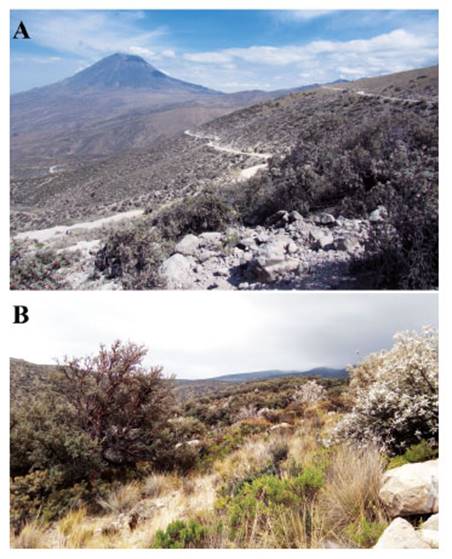
Figure 2 Queñua forest (Polylepis rugulosa Bitter), natural habitat of Bistriopelma fabianae sp. nov. A. El Simbral, approximately at 4100 m a.s.l. B. Caccayaco, approximately at 3500 m a.s.l. Photos by O. M. Quispe-Colca.
Male holotype (MUSA-AR 001): Total length 20.23; carapace (Figure 3A) length 9.54, width 8.85; chelicerae with 9 teeth on promargin. Cheliceral teeth pattern from the basal end: right side: VVVVVVV-V-V. Left side: VVVVVVVV- v. Anterior eye row slightly procurved, posterior eye row recurved. Eye sizes and interdistances: AME 0.24 (circular), ALE 0.28 (oval), PME 0.21 (oval), PLE 0.31 (oval), AME-AME 0.18, AME-ALE 0.11, PME-PME 0.66, PME-PLE 0.07, ALE-PLE 0.16, AME-PME 0.13, OQ length 0.67, width 1.33. Ocular tubercle strongly elevated, almost rounded (Figures 3C), length 1.04, width 1.33, clypeus narrow, 0.38 wide. Fovea transverse, deep (Figure 3A), width 1.91, 5.79 from the anterior edge of carapace. Labium length 1.34, width 1.57, anterior third with 9 cuspules, maxillae with 70-72 cuspules, located anteriorly in basal half on distinct basal tubercle (Figure 3G). Apical half of maxilla with short spiniform setae. Sternum (Figure 3B), length 4.37, width 4.13, with three pairs of sternal sigilla located near coxae III (oval, 0.19 long, 0.69 from the edge of sternum), coxae II (oval, 0.13 long, 0.34 from the edge of sternum) and near coxae I (circular, 0.12 long, 0.27 from the edge of sternum). Leg pattern: I>II>IV>III. Leg segments not incrassated. Leg measurements are presented in Table 1.
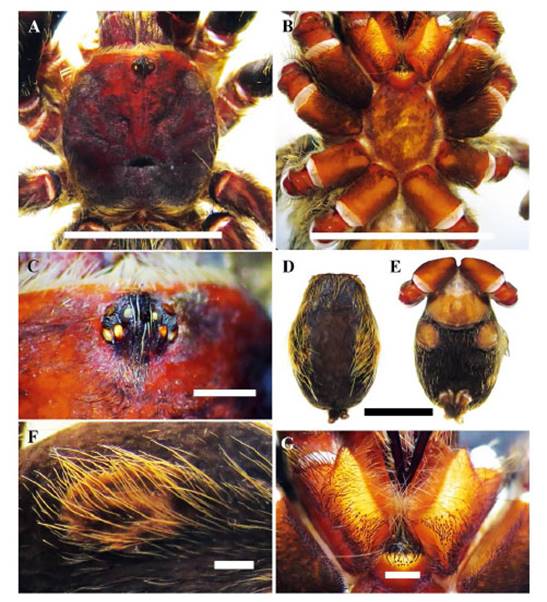
Figure 3 Bistriopelma fabianae sp. nov., male holotype (MUSA-AR 001). A. Carapace, dorsal view. B. Sternum, labium, maxillae and coxae, ventral view. C. Ocular tubercle, dorsal view. D. Abdomen, dorsal view. E. Abdomen, ventral view. F. Right patch of urticating setae, dorsolateral view. G. Maxillae and labium, ventral view. Scale bar = 1 mm (Figures C, F, G), scale bar = 5 mm (Figures D, E), scale bar = 10 mm (Figures A, B). Photos by O. M. Quispe-Colca.
Table 1 Bistriopelma fabianae sp. nov., male holotype (MUSA-AR 001). Lengths of palpal and leg segments.
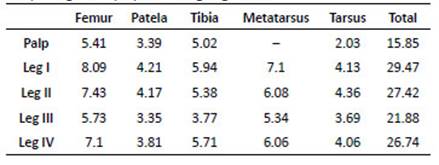
All tarsi, 100% scopulate, metatarsi I 100%, metatarsi II 90%, metatarsi III 50% and metatarsi IV 30% scopulate. Tarsi I-II with scopulae entire, with a thin longitudinal row of long setae, tarsi III-IV divided by a band of setae. Dorsal face of all tarsi and cymbium with two irregular longitudinal rows of very short claviform trichobothria. Denticulation pattern of paired tarsal claws on legs (prolateral/ retrolateral row): Right: I 5/6, II 4/4, III 4/4, IV 4/3; Left: I 5/6, II 5/2, III 3/4, IV 3/2. Plumose setae on retrolateral face of femur IV absent. Maxillary and trochanteral stridulatory bristles absent. Prolateral faces of coxae I and II densely covered with short spiniform setae.
Leg spination: Femora I p 0-0-(2-1), II p 1-(2-1)-1, III p 0-1-1, r 0-0-1, IV r 1-(1-0)-(1-0) and femora of palps 0; patellae I - IV and patellae of palps 0; tibiae I v (2-3)-2-0, p 1-(0-1)-(1-2), r 1-(1-0)-0, II v (4-3)-(3-1)-4 (apical), p 0-1-1, III v 2-2-3 (apical), p 0-(1-2)-0, r 1-1-0, IV v (10)-2-2 (apical), p 0-(1-0)-0, r 1-0-1 and tibiae of palps 0; metatarsi I v 0-0-1 (apical), p 1-0-0, II v 0-1-3 (apical), III v 2-2-3 (apical), p 0-(2-1)-0, r 1-1-0, IV v (1-0)-2-2 (apical), p 0-(1-0)-0, r 1-0-1; tarsi I - IV and tarsi of palps 0.
Pedipalp: Cymbial lobes of different sizes, prolateral lobe distinctly larger than retrolateral one. In the area between lobes there is a short apophysis densely covered with short spiniform setae. RL cymbial lobe (Figures 4A-C) is also covered with short spiniform setae. Palpal bulb (Figures 4D, 4E) with a narrow embolus projecting retrolaterally from tegulum, sigmoidly curved, and with two smooth subparallel prolateral keels, PS and PI keel. Tegulum with short conical basal apophysis. Palpal tibia is tapering to the apex, without retrolateral process.
Tibia I: Tibial apophysis with two branches of different sizes (Figures 4F, 4G): the first one is a long ventral branch with a single apical spine and two basal retro-lateral spines, and the second one is a short prolateral branch with a single inner spine, approximately of the same length. Slightly bent metatarsus I contacts the apex of ventral tibial apophysis when flexed.
Abdomen (Figures 3D, 3E): With type III urticating setae located in two dorsolateral patches, 3.29 distant from each other. Urticating setae patch (Figure 3F): length 4.85, width 2.32. Abdomen length 10.05, width 6.67. PLS three-segmented, length 3.30, basal segment 1.41, middle segment 0.62, apical segment 1.27, all digitiform. PMS (one segment), length 0.95.
Coloration (in life): Dorsal view: carapace dark brown, widely covered with coppery-brown setae between anterior edge of ocular tubercle and fovea, and long coppery-brown setae on margins. Ocular tubercle black. Legs dark brown with abundant long coppery brown setae, mainly on femora, as well as long pale setae. Abdomen dark brown widely covered with long coppery-brown setae extending from the base of abdomen towards the two dorsolateral patches of urticating setae, arranged diagonally to the longitudinal body axis. Patellae I, II and palpal patella with two almost equal longitudinal stripes without covering setae, patellae III, IV with two unequal diagonal stripes without covering setae. Ventral view: Labium and maxillae light brown. Sternum and coxae dark brown. Legs with long pale setae, femora with abundant long coppery-brown setae, all tarsi with iridescent scopulae. Abdomen dark brown, except for area above epigastric scutum and both posterior booklungs which are brown. Spinnerets dark brown.

Figure 4: Bistriopelma fabianae sp. nov., male holotype (MUSA-AR 001), A-C. Cymbium, A. Prolateral view. B. Ventral view. C. Retrolateral view. Arrows show a short apophysis between cymbial lobes, densely covered with short spiniform setae. D-E. Morphology of left palpal bulb. D. Retrolateral view. E. Prolateral view. F-G. Morphology of left tibia I. F. Prolatero-ventral view. G. Retrolateral view. T = Tegulum, PS = prolateral superior keel, PI = prolateral inferior keel, E = embolus. Scale bar: 1 mm. Photos and illustrations by O. M. Quispe-Colca.
Female paratype (MUSA-AR 105): Total length: 22.31; carapace (Figure 5A), length 11.2, width 9.39; chelicerae with 9 teeth on promargin. Cheliceral teeth pattern from the basal end: right side: V-VVVVV-V-Vv. Left side: VVVVVV-V-Vv. Anterior eye row slightly procurved, posterior eye row recurved. Eye sizes and interdistances: AME 0.36 (circular), ALE 0.37 (oval), PME 0.31 (oval), PLE 0.41 (oval), AME-AME 0.23, AME-ALE 0.15, PMEPME 0.74, PME-PLE 0.05, ALE-PLE 0.18, AME-PME 0.12, OQ length 0.77, width 1.62. Ocular tubercle elevated, almost rounded (Figure 5C), length 1.31, width 1.62, clypeus narrow, 0.32 wide. Fovea transverse, deep, slightly procurved (Figure 5A), width 2.16, 7.34 from the anterior edge of carapace. Labium length 1.22, width 1.75, anterior third with 8 cuspules, maxillae with 104−113 cuspules, located anteriorly in basal half on distinct basal tubercle (Figure 5G). Apical half of maxilla is ventrally covered with short spiniform setae.

Figure 5 Bistriopelma fabianae sp. nov., female paratype (MUSA-AR 105). A. Carapace, dorsal view. B. Sternum, labium, maxillae and coxae, ventral view. C. Ocular tubercle, dorsal view. D. Abdomen, dorsal view. E. Abdomen, ventral view. F. Right patch of urticating setae, dorsolateral view. G. Maxillae and labium, ventral view. The grey area represents a flat basal tubercle on which some cuspules are located. Scale bar = 1 mm (Figures C, F, G), scale bar = 5 mm (Figures D, E), scale bar = 10 mm (Figures A, B). Photos by O. M. Quispe-Colca.
Sternum (Figure 5B), length 4.97, width 4.87, three pairs of sternal sigilla located near coxae III (oval, 0.20 long, 0.81 from the edge of sternum), coxae II (oval, 0.19 long, 0.64 from the edge of sternum) and near coxae I (circular, 0.10 long, 0.51 from the edge of sternum). Leg pattern: I>IV>II>III. Incrassate leg segments absent. Leg measurements are presented in Table 2.
Table 2 Bistriopelma fabianae sp. nov., female paratype (MUSA-AR 105). Lengths of palpal and leg segments.
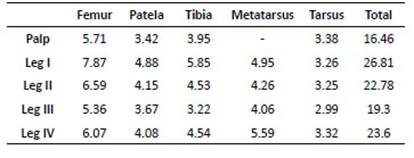
All tarsi 100% scopulate, metatarsi I 100%, metatarsi II 80%, metatarsi III 50% and metatarsi IV 30% scopulate. Tarsi I-II with scopula entire, tarsi III-IV divided by a wide band of setae. Dorsal face of all tarsi with two irregular longitudinal rows of very short claviform trichobothria. Denticulation pattern of paired tarsal claw on legs (prolateral/retrolateral): right: I 0/0, II 1/4, III 2/2, IV 1/0; left: I 0/0, II 4/1, III 2/0, IV 2/1. Plumose setae on retrolateral face of femur IV absent. Prolateral face of coxa I-IV densely covered with short spiniform setae.
Leg spination: Femora I p 0-0-1, II p 0-0-1, III-IV 0 and femora of palps p 0-0-1; patellae I - IV and patellae of palps 0; tibiae I v 0-1-1 (apical), p 0-0-1, II v 0-1-2, p 0-10, III v 0-0-2 (apical), p 0-1-0, r 0-1-0, IV v 0-0-1 (apical), r 0-0-1 and tibiae of palps v 1-2-3 (apical); metatarsi I v 1-0-1 (apical), II v 1-0-2 (apical), III v 0-2-3 (apical), p 0-1-1, r 0-1-1, IV v 0-0-3 (apical), p 0-0-1, r 0-1-1; tarsi I - IV and tarsi of palps 0.
Spermathecae (Figure 6A): Two separated seminal receptacles, fined grained, each distally terminated with transverse oval lobe, having two ventral projections.
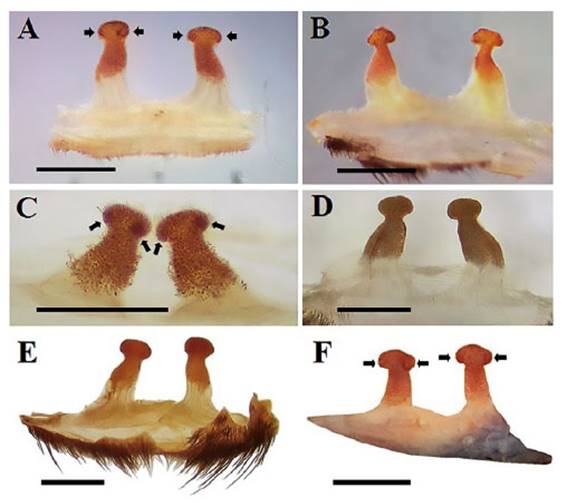
Figure 6 Spermathecae of Bistriopelma spp., ventral view, two ventral projections are marked by arrows. A. B. fabianae sp. nov., female paratype (MUSA-AR 105) from Arequipa. B. B. fabianae sp. nov., female paratype (MUSA-AR 104) from Arequipa. C. B. lamasi Kaderka 2015, female paratype (MUSM-ENT 0507717) from Ayacucho (Kaderka 2015: Figure 12). D. B. matuskai Kaderka 2015, female paratype (MUSM-ENT 0507716) from Apurimac (Kaderka 2015: Figure 13). E. Bistriopelma sp., female (MUSM-ENT 0511177) from Puno (Kaderka 2017: Figure 10e). F. B. titicaca Kaderka 2017, female paratype (MCZ 103144) from Puno (Kaderka 2017: Figure 10f). Scale bar = 1 mm. Photos by O. M. Quispe-Colca (Figure 6A, 6B).
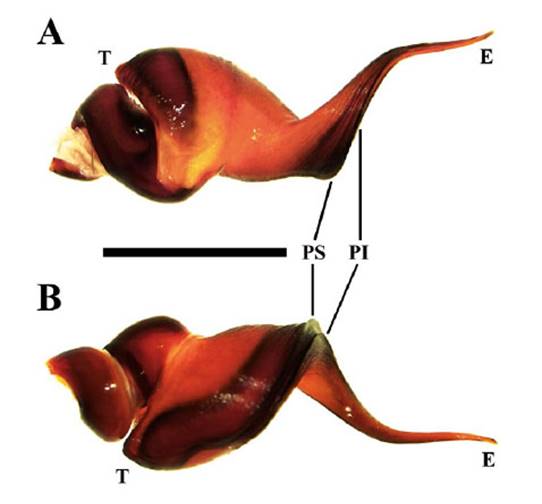
Figure 7: Bistriopelma peyoi Nicoletta et al. 2020, male holotype (MUBI 73), A-B. Morphology of left palpal bulb. A. Retrolateral view. B. Prolateral view. T = Tegulum, PS = prolateral superior keel, PI = prolateral inferior keel, E = embolus. Scale bar: 1 mm. Photos by Nelson Ferretti.
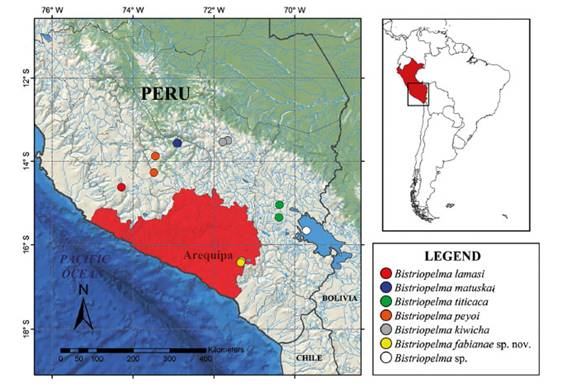
Figure 8 Distribution records of the genus Bistriopelma in Peru. White circle represents the record of this genus from Isla Amantani, Titicaca Lake. Map made by O. M. Quispe-Colca.
Abdomen (Figures 5D, 5E): With type III urticating setae located in two dorsolateral patches, 3.65 distant fromeach other. Urticating setae patch (Figure 5F): length 5.48,width 2.03. PLS three-segmented, length 4.08, basal segment 1.87, middle segment 1.12, apical segment 1.09, alldigitiform. PMS mono-segmented, length 1.19.
Coloration: Dorsal view: Carapace dark brown, with coppery-brown setae in a row between anterior edge of ocular tubercle and fovea, and long coppery-brown setae on margins. Legs dark brown with long coppery-brown setae, mainly on femora, as well as long pale setae. Abdomen dark brown, covered with long coppery-brown setae, in the areas of two dorsolateral patches of urticating setae thicker and arranged diagonally to the longitudinal body axis. Patellae I, II and palpal patella with two almost equal parallel longitudinal stripes without covering setae, patellae III, IV with two unequal diagonal stripes without covering setae. Ventral view: Dark brown, except for reddish brown maxillae and labium. Sternum covered with long coppery-brown setae. Legs with long pale setae, femora with abundant long coppery-brown setae, all tarsi with iridescent scopulae. Spinnerets dark brown.
Variation: Shape differences in the spermathecae are shown in Figures 6A-6B.
Biological and ecological notes: Bistriopelma fabianae sp. nov. represents the first official record of thefamily Theraphosidae in the Arequipa region, as well asthe southernmost and lowest altitude record for the ge-nus. The habitat of B. fabianae sp. nov is "Queñua" forest (Polylepis rugulosa Bitter) on the slopes of Pichu Pichuvolcano approximately in altitudes between 3500 and4200 m a.s.l. in the buffer zone of Salinas and AguadaBlanca National Reserve, Arequipa, Peru. This forest is located on the steep slopes with sandy-clay and stonysoils, in cold and arid environment of dry Puna (Mendoza et al. 2010).
The mean annual temperatures are about 3 - 8 °C,with the mean annual precipitation of approximately300 mm, being January to March the wettest months(INRENA 2007, Mendoza et al. 2010). The male holotypewas collected manually on May 2015 (autumn), it wasfound under a stone without any apparent shelter; thefemale paratype was also collected manually on January2018 (summer) inside a short burrow under a stone. Polylepis rugulosa is categorized as Vulnerable (D. S. 0432006-AG) and IUCN (World Conservation MonitoringCentre 1998), the forest is widespread in the buffer zoneof Salinas and Aguada Blanca National Reserve, however, it is exposed to constant logging and cattle overgrazing. In addition, the forest at El Simbral is highly fragmented caused by an unpaved road crossing throughout the forest. The ongoing habitat loss highlights the needto include the Polylepis forest in the national system ofprotected areas where its conservation and better management may be assured, and with it, other species, that appear to specialize on this kind of forests.












 uBio
uBio 


